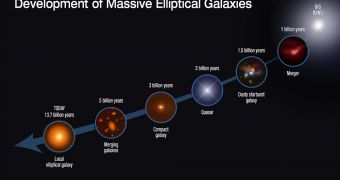An international team of astronomers, led by experts with the Dark Cosmology Center at the Niels Bohr Institute in Copenhagen, Denmark, was recently able to retrace the complex evolutionary history of the large, elliptical galaxies we see today. The work required massive volumes of data, as it centered on galaxies that started forming when the Universe was just a fraction of its current age.
For this investigation, astronomers used the European Space Agency's (ESA) Herschel Space Observatory, the NASA/ESA Hubble Space Telescope, the NASA Spitzer Space Telescope, as well as a host of other, ground-based observatories on Earth.
Together, Herschel, Hubble, and Spitzer make up an exquisite suite of instruments for investigating the Universe in infrared wavelengths, as well as for seeing within some of the dustiest and most remote objects ever to appear in space. These capabilities enabled the science team to investigate galaxies that started developing just 3 billion years after the Big Bang.
For more than a decade, astronomers have been trying to piece together the evolutionary history that led to the most massive elliptical galaxies we see today, but their success has been limited. Details of the new theories to explain this phenomenon appear in the January 29 online issue of the esteemed Astrophysical Journal.
“We at last show how these compact galaxies can form, how it happened, and when it happened. This basically is the missing piece in the understanding of how the most massive galaxies formed, and how they evolved into the giant ellipticals of today,” says DCC investigator and study leader Sune Toft.
“This had been a great mystery for many years because just 3 billion years after the Big Bang we see that half of the most massive galaxies have already completed their star formation,” the expert adds.
One of the ways in which compact elliptical galaxies went around the limitations in star formation imposed by the lack of additional molecular hydrogen gas for stellar formation was to merge with each other. These collisions, in addition to increasing their bulk, also stirred up whatever gas remained within these objects, leading to additional stellar formation.

 14 DAY TRIAL //
14 DAY TRIAL //